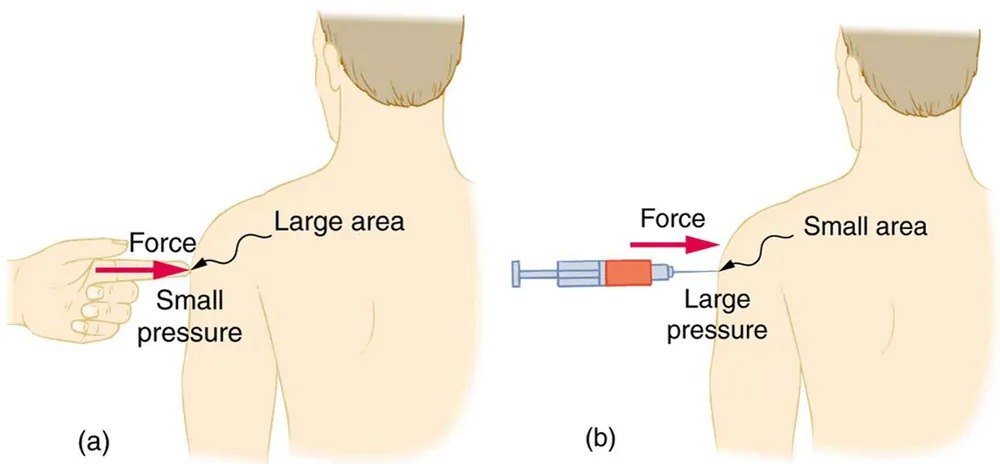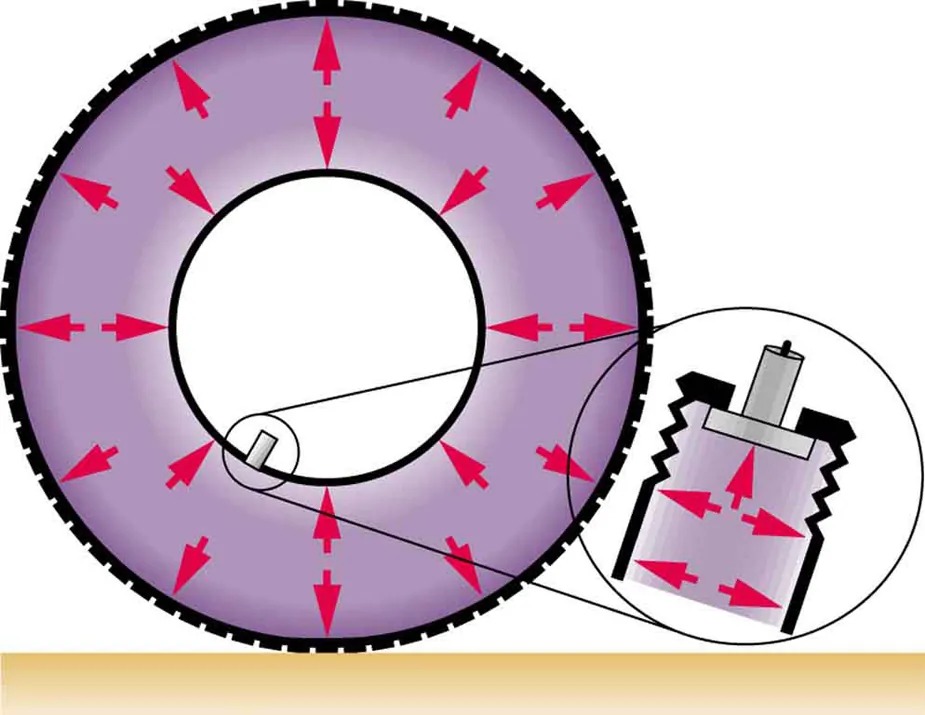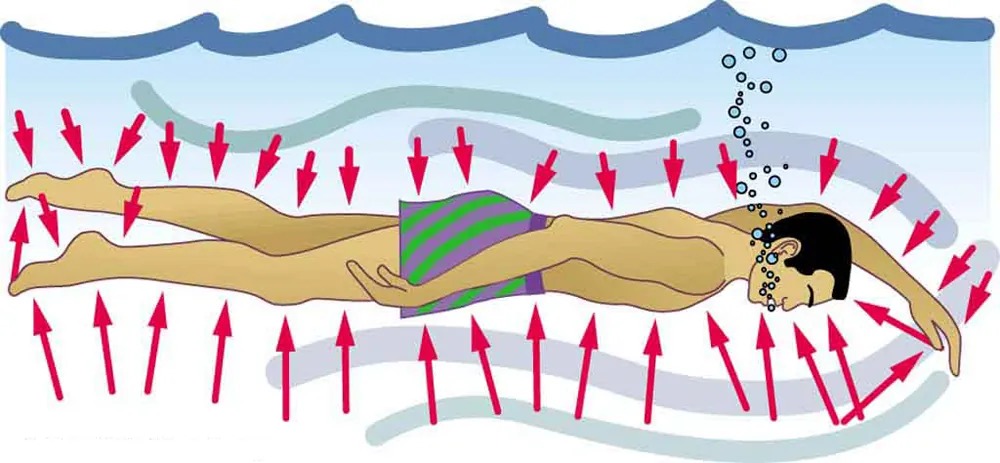9.3 Pressure
Learning Objectives
By the end of this section, you will be able to:
- Define pressure.
- Explain the relationship between pressure and force.
- Calculate force given pressure and area.
You have no doubt heard the word pressure being used in relation to blood (high or low blood pressure) and in relation to the weather (high- and low-pressure weather systems). These are only two of many examples of pressures in fluids. Pressure [latex]P[/latex] is defined as
[latex]P = \frac{F}{A}[/latex]
where [latex]F[/latex] is a force applied to an area [latex]A[/latex] that is perpendicular to the force.
Pressure
Pressure is defined as the force divided by the area perpendicular to the force over which the force is applied, or
[latex]P = \frac{F}{A} .[/latex]
A given force can have a significantly different effect depending on the area over which the force is exerted, as shown in Figure 9.5. The SI unit for pressure is the pascal, where
[latex]1 Pa = 1 \text{N}/\text{m}^{2} .[/latex]
In addition to the pascal, there are many other units for pressure that are in common use. In meteorology, atmospheric pressure is often described in units of millibar (mb), where
[latex]\text{100 mb} = 1 \times \text{10}^{4} \text{Pa} .[/latex]
Pounds per square inch [latex]\left(\text{lb}/\text{in}^{2} \text{or} \text{psi}\right)[/latex] is still sometimes used as a measure of tire pressure, and millimeters of mercury (mm Hg) is still often used in the measurement of blood pressure. Pressure is defined for all states of matter but is particularly important when discussing fluids.

Figure 9.5 (a) While the person being poked with the finger might be irritated, the force has little lasting effect. (b) In contrast, the same force applied to an area the size of the sharp end of a needle is great enough to break the skin. Image from OpenStax College Physics 2e, CC-BY 4.0
Image Description
The image consists of two illustrations labeled (a) and (b). Both depict the back view of a person’s upper body, specifically focusing on the shoulder area.
Illustration (a):
A hand applies force to the person’s shoulder with a flat surface. The force is directed with a red arrow pointing forward. The contact area is labeled “Large area,” and the resulting effect is described as “Small pressure.”
Illustration (b):
A syringe applies force to the person’s shoulder with the needle. The force is also indicated by a red arrow. The contact area is labeled “Small area,” and the resulting effect is described as “Large pressure.”
Example 9.2
Calculating Force Exerted by the Air: What Force Does a Pressure Exert?
An astronaut is working outside the International Space Station where the atmospheric pressure is essentially zero. The pressure gauge on her air tank reads [latex]6 . \text{90} \times \text{10}^{6} \text{Pa}[/latex]. What force does the air inside the tank exert on the flat end of the cylindrical tank, a disk 0.150 m in diameter?
Strategy
We can find the force exerted from the definition of pressure given in [latex]P = \frac{F}{A}[/latex], provided we can find the area [latex]A[/latex] acted upon.
Solution
By rearranging the definition of pressure to solve for force, we see that
[latex]F = \text{PA} .[/latex]
Here, the pressure [latex]P[/latex] is given, as is the area of the end of the cylinder [latex]A[/latex], given by [latex]A = πr^{2}[/latex]. Thus,
[latex]\begin{eqnarray*}F & = & \left(6.90 \times \text{10}^{6} \text{N}/\text{m}^{2}\right) \left(3.14\right) \left(0.0750\;\text{m}\right)^{2} \\ & = & 1.22 \times \text{10}^{5} \text{N}.\end{eqnarray*}[/latex]
Discussion
Wow! No wonder the tank must be strong. Since we found [latex]F = \text{PA}[/latex], we see that the force exerted by a pressure is directly proportional to the area acted upon as well as the pressure itself.
The force exerted on the end of the tank is perpendicular to its inside surface. This direction is because the force is exerted by a static or stationary fluid. We have already seen that fluids cannot withstand shearing (sideways) forces; they cannot exert shearing forces, either. Fluid pressure has no direction, being a scalar quantity. The forces due to pressure have well-defined directions: they are always exerted perpendicular to any surface. (See the tire in Figure 9.6, for example.) Finally, note that pressure is exerted on all surfaces. Swimmers, as well as the tire, feel pressure on all sides. (See Figure 9.7.)

Figure 9.6 Pressure inside this tire exerts forces perpendicular to all surfaces it contacts. The arrows give representative directions and magnitudes of the forces exerted at various points. Note that static fluids do not exert shearing forces. Image from OpenStax College Physics 2e, CC-BY 4.0
Image Description
The image depicts a cross-section of a tire with red arrows pointing inward, indicating the force or pressure being applied uniformly across the inner surface of the tire. There is a magnified inset showing a closer view of the tire valve, with further red arrows emphasizing the pressure inside. The background is a gradient from yellow to white, and the tire has a circular shape with a light purple hue.

Figure 9.7 Pressure is exerted on all sides of this swimmer, since the water would flow into the space he occupies if he were not there. The arrows represent the directions and magnitudes of the forces exerted at various points on the swimmer. Note that the forces are larger underneath, due to greater depth, giving a net upward or buoyant force that is balanced by the weight of the swimmer. Image from OpenStax College Physics 2e, CC-BY 4.0
Image Description
The image is an illustration of a person swimming in water. The swimmer is depicted in a horizontal position, wearing striped swim trunks with green and purple colors. The swimmer’s face is underwater, and bubbles are shown around their head, indicating exhalation. Their arms are extended, with one arm reaching forward and the other positioned by their side. The body is streamlined, suggesting a swimming motion.
Above and surrounding the swimmer are large blue waves representing the water’s surface and movement. Red arrows are positioned around the swimmer, both above and below the body. The arrows point inwards towards the swimmer, illustrating the buoyant force acting upwards from below the body and some resistance acting from above.
PhET Explorations
Gas Properties
Pump gas molecules to a box and see what happens as you change the volume, add or remove heat, change gravity, and more. Measure the temperature and pressure, and discover how the properties of the gas vary in relation to each other.

